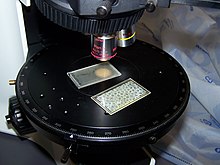Undiluted extinction
Undulating extinction (undulating: undulating) is a mineralogical term for the only partial extinction of a certain mineral under crossed polarizers. The analysis takes place under a polarizing microscope , the mineral is available as a thin section . Ideally, a mineral has a total extinction of the cross-polarized light every 90 degrees and the strongest brightening at 45 degrees. In the case of indolent extinction, this constant change (every 45 degrees) from light to dark does not take place; rather, it comes to a restless change. This phenomenon often occurs in tectonically stressed quartz , in which the rock was plastically deformed and the atomic lattice distorted.
backgrounds
When linearly polarized light crosses a transparent, anisotropic mineral in a thin section, the light beam is divided into two light waves oscillating perpendicularly to each other with different refractive indices . If the oscillation levels are different from the oscillation levels of the polarizer and the analyzer, the thin section is brightened. In contrast, if the planes of vibration are parallel to those of the polarizer or analyzer after they have passed through the crystal, then extinction occurs. If the specimen stage is rotated further, increasing interference occurs in the analyzer ; in the diagonal position, the maximum brightening is reached (shifted 45 degrees to total extinction). If you now turn the stage further, the mineral is darkened again and finally it comes to total extinction (again shifted by 45 degrees for the strongest brightening). In the case of plastically deformed minerals, e.g. B. quartz, the atomic lattice is so distorted that the light rays no longer have a uniform level of vibration and there is an undulating extinction. This is due to the fact that part of the light is stopped by the analyzer (vibration plane parallel to the analyzer) and the other part is not (vibration plane different from the analyzer).
literature
- Hans Pichler, Conelia Schmitt-Riegraf: Rock- forming minerals in thin sections . Ferdinand Enke Verlag, Stuttgart 1987 ISBN 3-432-95521-9 .

